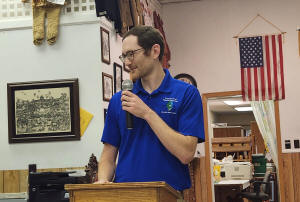|
The Logan County Genealogical and
Historical Society hosted their monthly program on September 15,
2025, with Trevor Thompson, Site Services Specialist at New Salem
Village just outside of Petersburg, IL giving the presentation.
Many have visited the village, a reproduction of the frontier
settlement where Abraham Lincoln lived for a few years, clerked at
the store, began his journey into adulthood. Thompson gave an
overview of the major maintenance project to update the buildings
and addressed preservation issues.
Thompson has worked at New Salem Village for eight years. He grew up
in nearby Williamsville and got a history degree from Greenville
College (University).
Over the years, Thompson has been a Civil War reenactor with the
114th in Springfield, Illinois, worked at the Lincoln Home National
Historical site, Abraham Lincoln Presidential Library Museum and
finally New Salem Village.
When Thompson got a masterís degree in American history from
Gettysburg College, he decided to study more about the history of
New Salem after Abraham Lincoln left there. He said he could talk on
Lincolnís New Salem for hours, but he had to work the next day.
Thompson then gave a history lesson on what is going on in New Salem
Village. He said in March, it was announced that they were getting
$8,000,000 to spend on renovating the village. Though it sounds like
a lot of money, it can go fast in todayís world.
Thompson is working on publishing a history of New Salem from 1865
when Lincoln was assassinated until the point at which it became a
solid historical site.
Abraham Lincoln arrived in New Salem in 1831 and stayed there for
six years. While living there, Lincoln was a lawyer and then became
a politician. Thompson said that snowballed all the way to
Springfield until Lincoln ran for president in 1860 and won.
The problem with New Salem is that it only lasted ten years.
Thompson said the village was founded in 1829 and pretty much gone
by 1840. After Lincoln left in 1837, the village lasted about three
years, and Thompson said it then basically became a pasture.
As Thompson often tells kids, the log buildings were similar to
Lincoln Logs, so people dismantled the buildings and moved on to the
next village.

Thompson said no one really cared
about New Salem and forgot what had happened there until Lincoln was
assassinated in 1865.
Lincolnís last law partner, William Herndon, then decided to compile
what happened at New Salem and throughout Lincolnís life. Herndon
sent out letters to people who knew Lincoln 20 to 30 years prior.
Thompson said there were all these stories that were passed along.
Letters were even sent to kids and grandkids of the people who lived
there just to ask what their dad or mom said about Abraham Lincoln.
Herndon, who Thompson referred to as Lincolnís biographer, does a
great job of compiling the information. Herndon did many lecture
series and talked about it extensively. All the letters Herndon
compiled have been published in many ways and are now accessible.
Thompson said when Herndon started talking about New Salem, people
from the area would go visit but found nothing but pastures and one
building. There were not even trees.
In the 1890s, Thompson said there were people with all kinds of
ideas, which he said can be great and not so great. For instance,
Thompson said since Lincoln was a popular guy there was talk about
making New Salem into an amusement park. Some wanted to build a
museum and memorials to Lincoln.
None of that happened. Thompson said people decided to have a
Chataqua and founded the Old Salem Chataqua Society.
Around one and a half miles from where Lincoln lived for six years,
there was a huge Chataqua where 6,000 people came for two weeks in
August. Thompson said people were talking about all kinds of things
and learning all kinds of things. Every year, the people would talk
about New Salem and what happened when Lincoln lived there.
Eventually, Thomspon said the event caught on and got a few
prominent people who started asking what they could do.
Newspaper magnate William Randolph Hearst visited and said, ďIíve
got some money, Iíll go buy it.Ē Hearst approached the people who
lived there and 1906, bought the whole lot from the Bale family and
various other people.
Thompson said Hearst then deeded the village to the Old Salem
Chataqua Association with the condition that they reconstruct the
village. Members of the Association agreed to do that because there
were many big things coming up in their history that they thought
people would get behind.
Three years away from the centennial of Lincolnís birth, Thompson
said the group decided to rebuild the village. There were plans to
start on February 12, 1909 [which would have been Lincolnís 100th
birthday] and lay the cornerstone. They planned to rebuild 25
buildings.
It did not happen, and Thompson said it was not totally their fault.
Epidemics, pandemics and other events in the early 1900s derailed
the plans. The association said they would do something in a couple
more years, but Thompson said World War I happened.
There was a downward spiral of attendance at the Chataqua. People
were still coming, but Thompson said there were not the numbers they
were see in the 1890s and early 1900s.
At that point Thompson said Hearst considered taking away the deed
and finding something else to do with the land or even selling it.
The Old Salem Lincoln League decided to rebuild the village.
Thompson said the league began collecting four-dollar membership
dues to reconstruct the buildings. Of the four-dollar dues, three
dollars went to reconstruct the village, and one dollar went to
their membership meeting every year.

In 1918, when the centennial of
Illinois Statehood was around the corner, Thompson said the league
thought it would be nice to do a pageant. They had all this history
and felt they were the best Lincoln site across the state.
With the help of about 100 volunteers, Thompson said the league
rebuilt four buildings in one day. They had plans to put on a huge
pageant in about three months.
On September 6, 1918, there was big play with around 300
participants and 5,000 people who came to see the pageant about
Abraham Lincoln, Lincolnís New Salem and what it was like when he
lived there.
Thompson said all the newspapers articles were very honest in saying
we are doing this because we want the state of Illinois to take
notice.
In early 1919, the state decided to make the area Old Salem State
Park. Thompson said it was only the third state park in the state of
Illinois.
Historical preservation did not actually start until the 1960s, so
Thompson said it was very lucky New Salem was founded before that.
Governor after governor from both political parties would say they
were going to invest in the park. He said some were fans of Lincoln,
while others were not.
From there on, Thompson said it becomes a weird history about how
the village was constructed. He often hears two things from people.
One is belief they rebuilt every single building where they thought
they would go. The second thing people think is they brought in all
the buildings from other places.
Thompson said these ideas come from peopleís visits to places like
Henry Fordís village in Michigan and Colonial Williamsburg. Both
were reconstructed around the same time as New Salem.
In the early 1900s, Thompson said they leaned on William Randolph
Hearst for his financial backing to buy the site. They gave it to
the local community, and the local community gets so invested and
they start doing all the history.
The Old Salem Lincoln League started flagging every single site.
Thompson said they used multiple maps that were handed down by all
the people and put flags on every little plot they used the surveys
for.
The group tried to get it as accurate as possible and started
digging. Thompson said historic preservationists would cringe a
little bit since they were digging and not collecting anything. They
were just digging just to see where things were and not documenting
it. He said they put those on the flags down and that's how they
left the site for about 10 years.
Thomspon said there were all these
flags up there and really no documentation, but people were still
coming by the thousands to see this Old Salem Hill. The people would
mainly see a lot of flags and know something had been there.

[to top of second column] |

New Salem site manager Trevor Thompson. Photo by Angela Reiners

The area was left
that way for ten years as the state of Illinois continued to
take their time on the project. Thompson said the state was
sitting on this nice new State Park, which was more or less a
piece of grass for people to come have a picnic on.
Then, Thomspon said they decided to rebuild or get one of the
original buildings. They had taken the old house of Henry
Onstott, the town Cooper, who had actually taken his house just
down the street to Petersburg.
In 1922, Thompson said they were actually selling that house or
at least the one next to it. Someone had tried to change the
Cooper shop into a garage and so all they had to do was strip
off the new material on there and they had the original logs. He
said the cool part is that the house is still there. The cooper
shop is the only original building.
During the 1920s, little was done at New Salem, but Thomspon
said in the 1930s, things began to change just a little bit at
least nationally. The state of Illinois decided they were going
to make their best effort and so they hired an architect firm to
come and start doing some of the digging and planning.
Soon, Thompson said 13 buildings were built by English Brotherís
Construction. Everything that was done was recorded and he said
historians love it because it's the only prime example of
documenting. Joseph Buton wrote about it in A Record of
Restoration.
In 1934, the Civilian Conservation Corps was established and
Thompson said New Salem became their project for seven years.
Seven out of twenty three buildings were rebuilt. He said a
campground was added and an amphitheater was put up. The Corps
built a grist mill, a maintenance building, a superintendentís
house, roads and parking lots. They also planted trees, so
Thompson tells people they can thank the CCC for the shade.
Thompson said the CCC did a lot of great work, and though not
criticizing their work, he felt they made it more of a park than
historic site. With all those added trails, it's a great place
for local people but when people come from faraway places, some
say ďoooh you have a campground, ooh you have trails, and you
have a boat ramp.Ē
As Thompson said, New Salem does have all of those, but the main
reason people are here is Lincolnís new Salem historic village.
He said people have debated whether the CCC did a disservice.
In the end, Thompson
said New Salem is very much what you want it to be.
With the state government, federal government and local community
involved with work at New Salem, Thompson said there were arguments
over things like flagpoles and this news made it into papers.
However, the local community was still invested in the site.
People were still doing work there. Thompson said two notable people
were Fern Nance Pond and Kitty Warranting. They went to people they
knew in Petersburg and asked if they had anything old in their
house. The women wanted to look at artifacts from the 1830s. They
definitely wanted to see anything Lincoln might have touched.
Thompson said they collected about 3500 artifacts from that time
period. They had categories and did the history. He said they found
artifacts such as the surveying equipment Lincoln used or one of the
law books Lincoln had.
The group collecting artifacts outfitted the entire village and what
you see today is what they found. The site has gained a few
artifacts since the 1930s and 40s and of those 5000 artifacts now
there, 3,500 were found and archived. Some of it had belonged to
Lincoln and other artifacts were from that era. For 20 years,
Thompson said 5000 artifacts have been at the site.

About 35,000 people bought catalogs of
the artifacts. Thompson said the catalogs cost a quarter. These
catalogs were made every year until 1947 or 1948.
Thompson the historic village itself opened to the public in the
1940s right after World War II. People started coming just like they
were before, but in in much larger quantities. People that traveled
the country were taking the roads through the United States and
stopped in little New Salem.
Thompson said the park was under the Illinois Department of Natural
Resources then later the Illinois Historic Preservation Agency. The
Agencyís mission is to preserve, protect and interpret and
reconstruct.
When these buildings were rebuilt in the 1930s and 40s, Thompson
said they were only made to probably last about 30 years, which was
the realistic expectation. He said the 1980s saw some rebirth and
cleaning up.
About the 1990s to early 2000s, the Abraham Lincoln Presidential
Library was being planned. When they opened in 2005, Thompson said
less money came into New Salem.
In 2020, Governor JB Pritzker visited and was the first governor
since Jim Edgar visited the site. Thompson said Pritzker saw the
issues with the village when he visited.
In March 2025, Thompson said $8,000,000 was earmarked by the Capital
Development Board and the money will be used to restore some
buildings. He said they are hitting the ground running, and though
he cannot tell, there are many things the money will be used for in
the historic village. Many of the buildings will get a little bit of
makeover, a lot of roofs, and a lot of porches.
Thompson said every building probably has its own little quirks and
so right now the engineer teams are out there talking about how much
the work will cost. As he said $8M will go very fast, but today they
are still a historic site.
Currently, Thompson said the site has had about 500,000 visitors
this year and his goal is 750,000. That's why they are doing three
weekends of their candlelight event, which is one of their two
biggest events. The candlelight event is now 3 weekends for three
nights on Friday, Saturday and Sunday. He said they expect around
4000 people every single night.
Between the 1950s and 1980s, Thompson said the local community did
not get along with the people who ran the site.
David Hedrick saw how rundown the area was in the 1980s and got New
Salem Lincoln League to help out by getting volunteers to do some
work.
Though Thompson started as an interpreter at New Salem, he later
became more involved in history and administrative work. He now
writes a lot about New Salem but also gives talks.
It is challenging to piece together some of the story of New Salem,
but Thompson wants to give the full history on why it looks the way
it does. He said they may do something special there in 2031, which
is the bicentennial of the village. Big things are coming.
When Thompson asked questions, some asked about whether the original
village was south of the woods and how many were there during
Lincolnís time.
Thompson said the foundations of the buildings are as close to the
original plotlines as possible. Most are on the original site
further in the woods where the schoolhouse was, so it is on a
different foundation.
About 25 people lived in the village during Lincolnís time including
cobblers, traders and others.

There was another question about when
New Salem village is open.
Throughout the year, Thompson said New Salem is open Tuesday through
Saturday from 9 a.m. to 5 p.m. People can also walk out there before
dark and other times when interpreters are not there. The
Candlelight walks, which Thompson said started in the 1980s, will be
held 5 p.m. to 7:30 p.m. on Friday, Saturday and Sunday during the
first three weekends of October. Visitors will see the sun go down
and hopefully not need flashlights.
After Thompson was finished, a short business meeting was held.
LCGHS Program Chair Marla Blair said October 20, Lincoln Heritage
Museum Director Jonathan Parker will speak.
[Angela Reiners] |